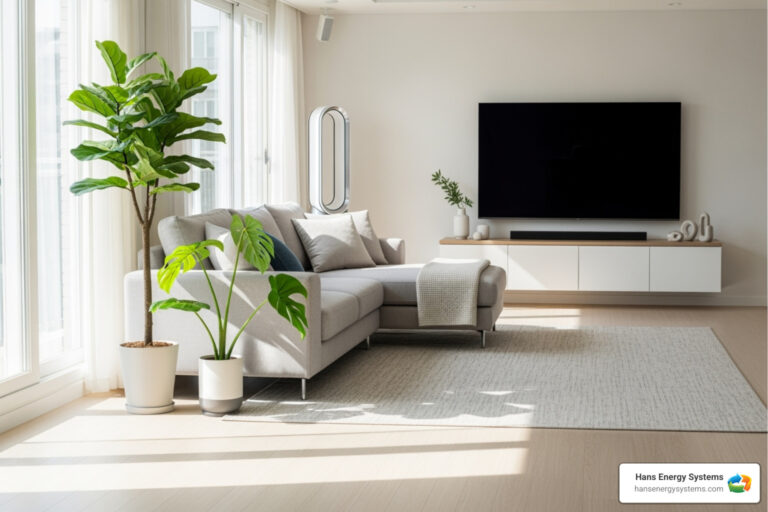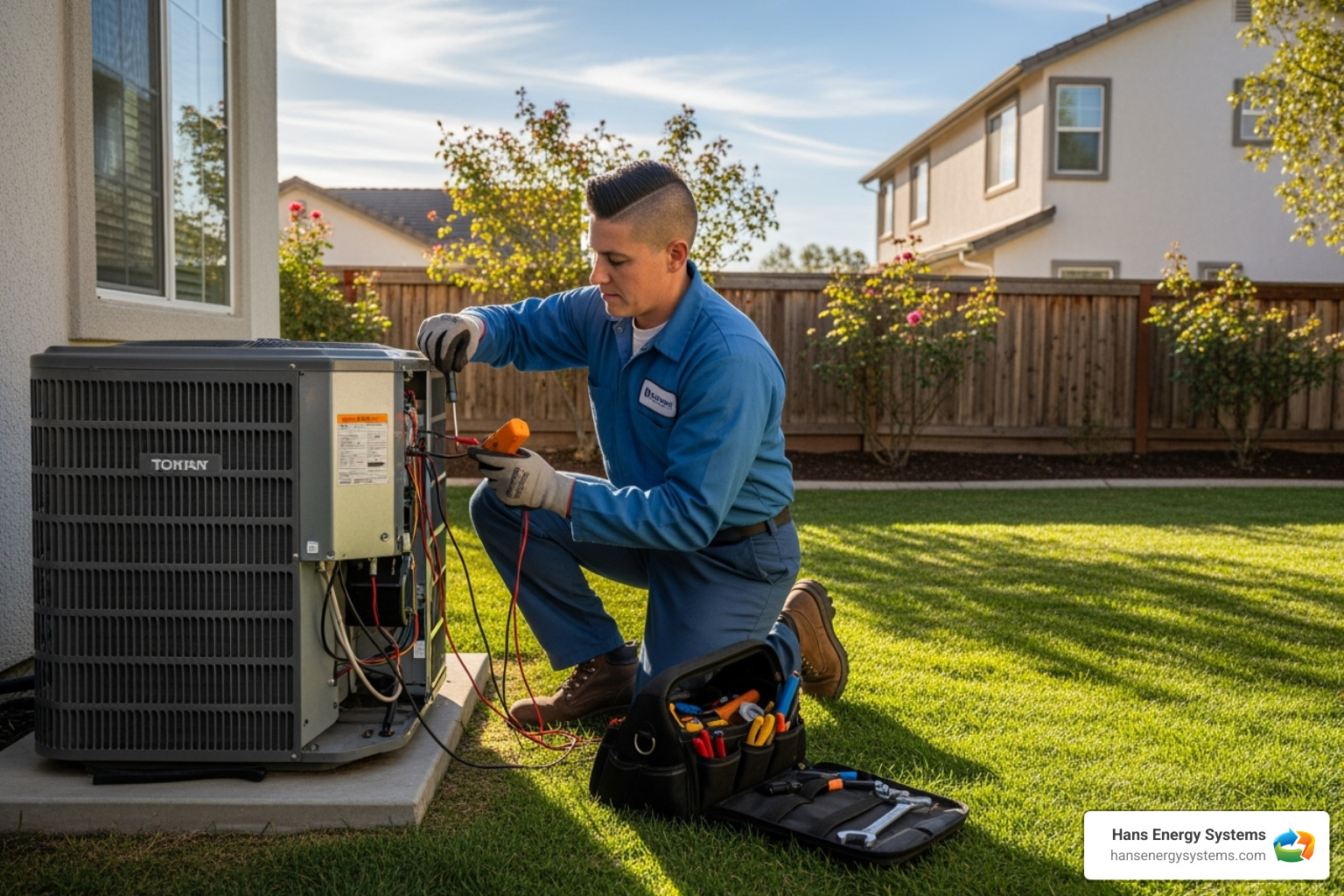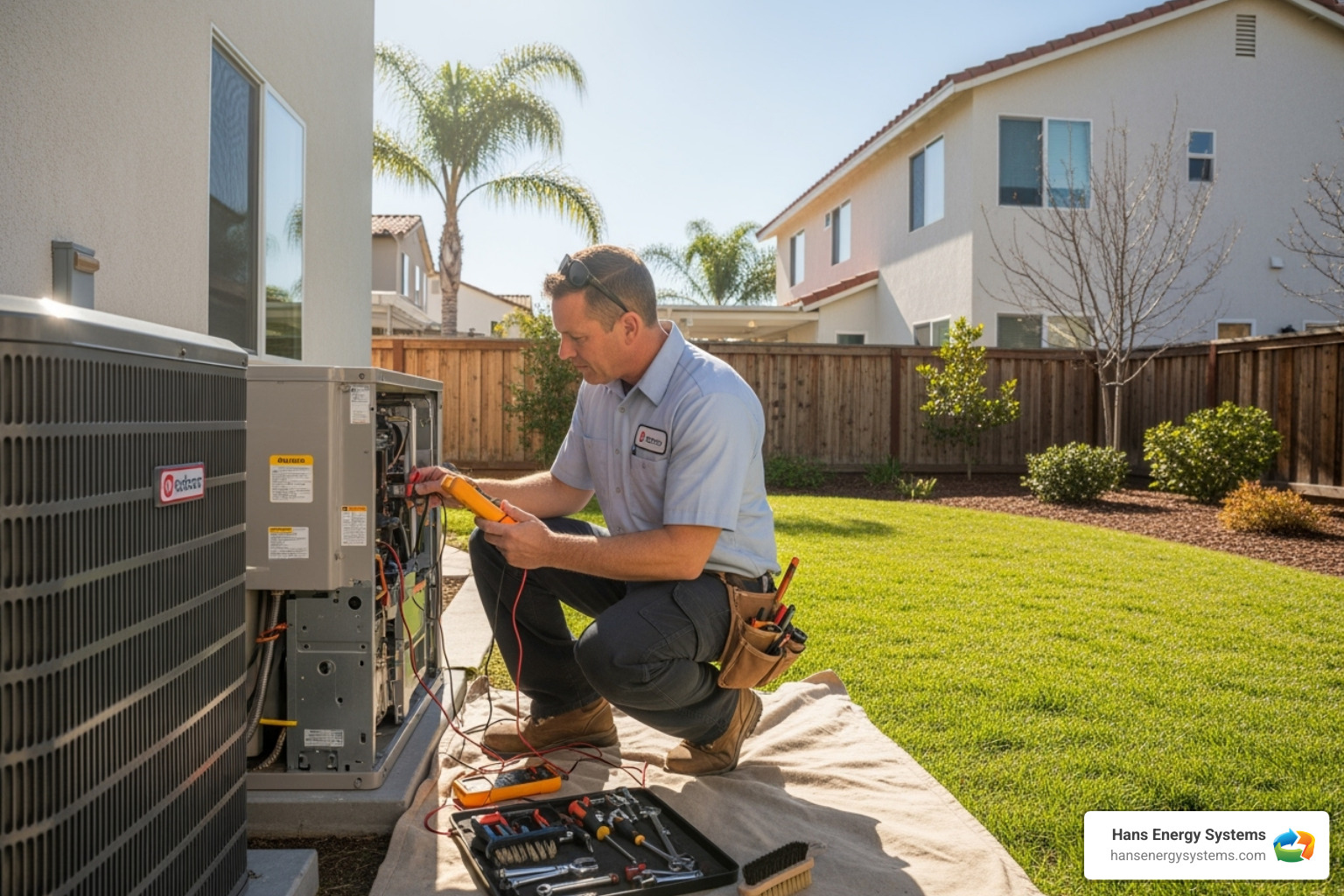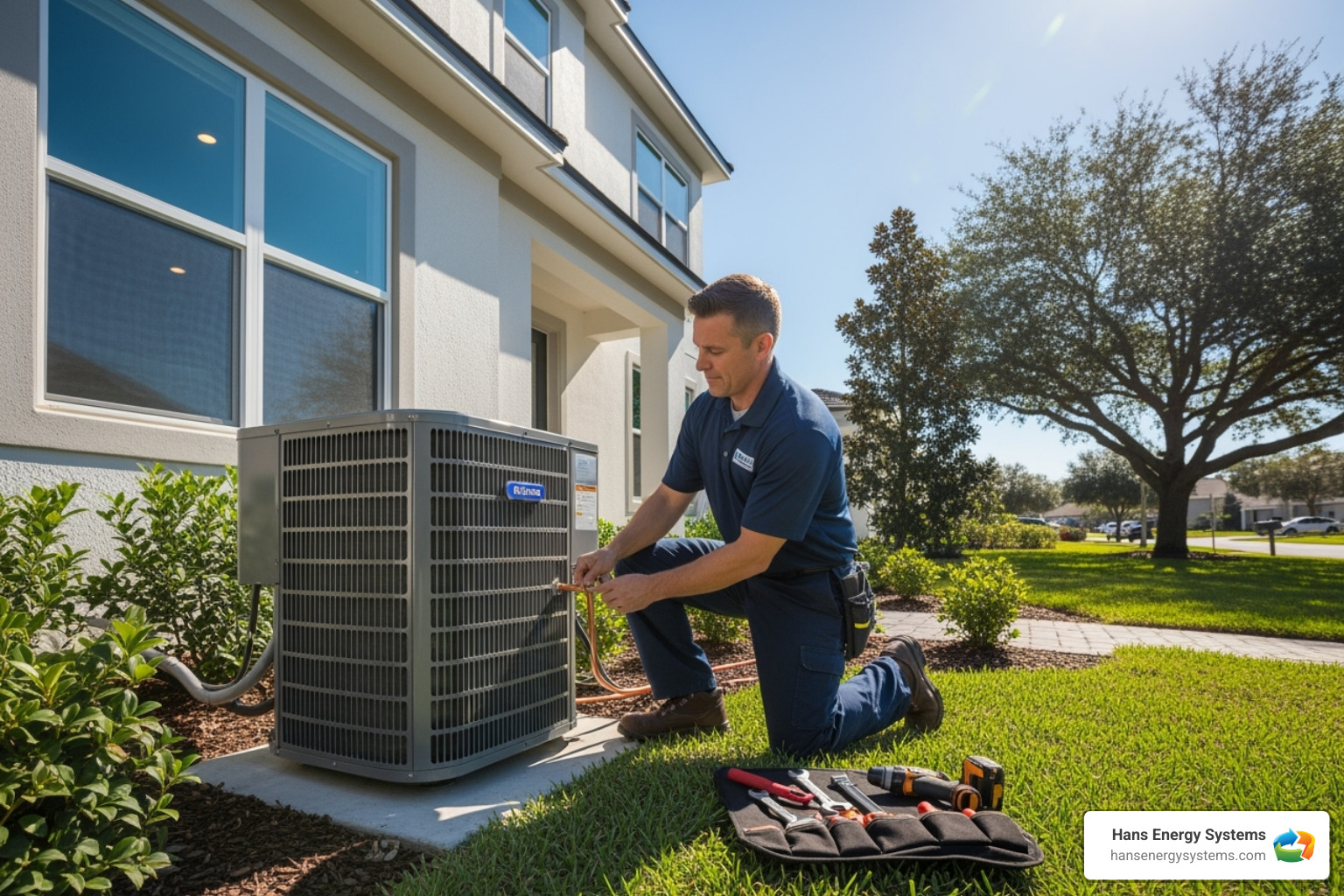Why Your Home’s Air Quality Deserves Your Attention
Air quality solutions are essential systems and strategies that help remove pollutants, improve ventilation, and create healthier indoor environments. Here are the main types available for homeowners:
- Source Control: Eliminating pollution at its origin (proper storage of chemicals, fixing gas leaks)
- Ventilation Systems: Bringing fresh outdoor air inside while removing stale air
- Air Filtration: Using MERV-rated filters in HVAC systems to trap particles
- Air Purification: Technologies like UV lamps and electronic air cleaners that neutralize contaminants
- Professional Testing: Identifying specific pollutants and getting customized solutions
You might be shocked to learn that indoor air can be 2-5 times more polluted than outdoor air, according to the EPA. This matters because most of us spend about 90% of our time indoors – whether at home, work, or school.
Poor indoor air quality isn’t just uncomfortable. It triggers allergies, worsens asthma, causes headaches, and can even reduce your ability to think clearly. Studies show that poor indoor air quality is linked to absenteeism and reduced cognitive function.
The good news? You have more control over your indoor air quality than you might think. This guide will walk you through practical solutions that work – from simple DIY steps you can take today to advanced whole-home systems that provide long-term protection.
Whether you’re dealing with dust, pet dander, cooking odors, or just want to breathe easier, we’ll help you understand your options and make informed decisions about your family’s health.

The Invisible Threat: Understanding Indoor Air Pollution
Ever walk into a room and feel like something’s not quite right? A musty smell, heavy air, or a tickle in your throat are signs your body is picking up on poor indoor air. Our homes can harbor numerous invisible pollutants we breathe daily. These are genuine health concerns that affect how we feel, sleep, and function.
Volatile Organic Compounds (VOCs) are gases that escape from everyday items like paint, cleaning products, air fresheners, and new furniture. While some smell pleasant, they can cause headaches, throat irritation, and more serious long-term health issues.
Mold and mildew love to set up shop wherever there’s moisture. That means your bathroom, basement, or anywhere you’ve had a leak becomes prime real estate for these fungi. When mold releases its spores into the air, it can trigger everything from sneezing fits to serious asthma attacks.
Dust mites in your bedding and carpets might be microscopic, but their impact isn’t. These creatures feast on dead skin cells, and their waste becomes airborne allergens that cause stuffy noses and itchy eyes.

If you have pets, pet dander adds another layer to your indoor air quality puzzle. Even the most well-groomed animals shed tiny flakes of skin and hair that float through your home’s air, causing allergic reactions in sensitive family members.
Combustion gases from gas stoves, fireplaces, and heating systems pose a more serious threat. Carbon monoxide is particularly dangerous because it’s completely odorless and colorless, yet can be deadly. Even nitrogen oxides from these same sources can irritate your respiratory system over time.
The short-term effects of breathing polluted indoor air can show up quickly. Allergies seem to get worse, asthma attacks become more frequent, and those mysterious headaches might actually be your body’s way of telling you the air quality needs attention. Perhaps most surprising is how poor air quality can affect your ability to think clearly – studies show that reduced cognitive function is directly linked to breathing contaminated air.
The long-term health impacts are even more concerning. Breathing poor quality air day after day can contribute to respiratory diseases like chronic bronchitis, and research continues to link indoor air pollution to more serious conditions affecting your heart and overall health.
When you consider that we spend about 90% of our time indoors, taking control of your home’s air quality becomes a no-brainer investment in your family’s health and comfort. The EPA guide on indoor air quality provides additional details about these pollutants and their effects.
The good news? Understanding these invisible threats is the first step toward breathing easier. Air quality solutions exist for every type of pollutant, and many are more accessible than you might think.
A Three-Pronged Approach to Cleaner Air
Improving your home’s air doesn’t have to be complicated. A three-pronged approach provides a stable foundation for healthier living.
The first is source control, your most powerful weapon against indoor pollution. This means stopping problems before they start by eliminating pollutants at their origin. For example, fixing a gas leak prevents combustion gases from contaminating your air, and choosing low-VOC paints reduces chemical fumes.
The second is ventilation, which gives your house the ability to breathe. It involves a consistent, controlled exchange where fresh outdoor air comes in and stale, polluted indoor air gets pushed out.
The third is air cleaning, which uses technology to filter or purify your air. These systems capture and neutralize particles, gases, and microorganisms that ventilation might miss. These air quality solutions work behind the scenes to grab pollutants that might otherwise circulate through your home.
As a homeowner, you have more control than you might think. Regular cleaning makes a huge difference – when you dust surfaces and vacuum with a HEPA filter, you’re physically removing the dust mites and pet dander that love to accumulate in carpets and upholstery. Using low-VOC products whenever possible, from your bathroom cleaner to that new couch you’re eyeing, keeps chemical emissions to a minimum. And don’t forget about proper ventilation during cooking – those sizzling pans and roasting vegetables release more particles into the air than most people realize.
The Power of Ventilation
Ventilation might not sound glamorous, but it’s absolutely essential for healthy indoor air. Think of your home as a living, breathing space that needs a constant supply of fresh air to stay healthy.
Natural ventilation is the simplest approach. Cross-breezes from open windows can work wonders for clearing out accumulated pollutants, especially after you’ve been cleaning or cooking. Your bathroom and kitchen exhaust fans are also part of this approach, grabbing moisture and contaminants at the source and sending them outside.
However, many modern homes are built so tightly for energy efficiency that natural ventilation isn’t enough. This efficiency can trap pollutants inside.
That’s where mechanical ventilation systems shine. Whole-house ventilation systems work like the lungs of your home, mechanically bringing in fresh outdoor air and distributing it throughout every room. The really smart ones, called Energy Recovery Ventilators (ERVs), are particularly clever – they bring in that fresh air while capturing energy from the air going out. This means you get clean air without watching your energy bills skyrocket.
At Hans Energy Systems, we know that your HVAC system plays a crucial role in keeping your air fresh and clean. While many older heating and cooling systems weren’t designed to bring in outdoor air, we can evaluate what you have and suggest air quality solutions that work perfectly with your existing setup. Sometimes a few strategic upgrades can transform your current system into a powerful ally for better air quality.
For homeowners who want to dive deeper into their options, the U.S. Dept. of Energy’s guide on whole-house ventilation offers excellent technical details. And remember, proper ventilation is an important part of comprehensive HVAC maintenance in Poway, CA – it’s not just about keeping your system running, but ensuring it supports a healthy indoor environment for your family.
Simple Steps for Proactive Improvement
You can start making a difference today with simple, effective steps that don’t require a large investment or contractors.
Regular dusting and vacuuming is your first line of defense, especially in carpeted areas and around upholstered furniture. A vacuum with a HEPA filter is worth its weight in gold – it actually traps those microscopic particles instead of just stirring them around.
Using your kitchen and bathroom exhaust fans is crucial when cooking or showering. Those fans work to pull moisture and airborne particles straight outside where they can’t cause trouble.
Avoiding harsh chemical cleaners is easier than ever. Simple ingredients like vinegar and baking soda can tackle most cleaning jobs without filling your home with VOCs. If you prefer commercial products, look for ones labeled as “green” or low in volatile organic compounds.
Managing humidity levels between 30-50% creates an environment where mold and dust mites can’t thrive. A dehumidifier can be a game-changer, especially in basements or other damp areas.
Don’t forget about changing your HVAC air filter regularly – we’ll talk more about this crucial step in the next section. And whenever weather permits, opening windows and doors gives your home a natural refresh, particularly after activities like cleaning or painting.

Exploring a Spectrum of Air Quality Solutions
While opening windows and regular cleaning are your first line of defense, air quality solutions integrated with your HVAC system create a powerful second layer of protection that works around the clock.
Your HVAC system already moves air throughout your home. When air quality solutions are integrated, they treat every bit of air that flows through your house, acting as a constant air quality guardian.
At Hans Energy Systems, we’ve seen how whole-home solutions transform indoor environments. Instead of trying to clean the air in individual rooms with portable units, these integrated systems work with your existing ductwork to provide comprehensive coverage. Every time your system runs, whether heating or cooling, it’s also actively improving your air quality.
Of course, room-specific improvements like portable air purifiers can still play a valuable supporting role, especially in bedrooms or home offices. But for maximum effectiveness and convenience, integrating solutions directly into your HVAC system is often the most impactful and cost-effective approach.
Filtration Fundamentals: Understanding Air Filters and MERV Ratings
Let’s start with the basics: the air filter. Every time your HVAC system runs, air gets pulled through this fibrous barrier, which traps airborne particles.
This is where MERV ratings become your best friend. MERV stands for Minimum Efficiency Reporting Value, and it’s a report card for how well a filter catches particles. The scale runs from 1 to 20, and higher numbers mean better filtration.
Most basic MERV 1-4 filters are designed to protect your HVAC equipment from large dust, but they do little for your air quality as smaller particles pass right through.
Mid-range filters (MERV 5-8) are better for homeowners, as they can grab pollen, dust mites, and mold spores. If you have mild allergies, stepping up to a MERV 8 filter can make a noticeable difference.
MERV 13 filters are workhorses that can capture at least 85% of particles between 1.0 and 3.0 microns, plus about half of the even tinier particles between 0.3 and 1.0 microns. This includes fine dust, pet dander, smoke, and even some bacteria and viruses. Many experts consider MERV 13 the sweet spot for meaningful indoor air quality improvement.
There’s just one catch – your HVAC system needs to be able to handle the denser filter without working too hard. Our team at Hans Energy Systems can help you find that perfect balance where you get great filtration without overworking your system. A dirty air filter can harm your AC efficiency, so regular changes are crucial no matter what MERV rating you choose.
Here’s a quick comparison of popular filter options:
| MERV Rating | Particle Capture Efficiency (0.3-10 microns) | Common Uses & Particles Captured |
|---|---|---|
| MERV 8 | 20-69% (3-10 microns) | Basic residential, captures pollen, dust mites, carpet fibers |
| MERV 11 | 65-79% (1-3 microns), 20-49% (0.3-1 microns) | Better residential, captures pet dander, mold spores, humidifier dust |
| MERV 13 | 85-90% (1-3 microns), 50-74% (0.3-1 microns) | Superior residential, commercial, captures smoke, smog, bacteria, some viruses |
Advanced Air Quality Solutions: Purification Technologies
While high-quality filters are fantastic, some situations call for more advanced air quality solutions. These technologies go beyond just trapping particles – they actively neutralize, destroy, or transform pollutants into harmless substances.
Electronic air cleaners use an electrostatic charge to attract and capture ultra-fine particles that traditional filters miss. These systems are highly effective at removing these particles, and many produce clean air without generating harmful ozone.
UV lamps are like having a miniature sun working inside your HVAC system. These powerful lights get installed near your evaporator coil, where moisture and darkness create perfect conditions for mold and bacteria growth. The ultraviolet light is lethal to these microorganisms, killing them before they can circulate through your home.

Cold plasma generators represent some of the most exciting advances in air purification technology. These devices create millions of positive and negative ions that attach to airborne particles, making them larger and easier for your filter to capture. They can also neutralize viruses, bacteria, mold, and odors at the molecular level. Some advanced systems can even sanitize surfaces throughout your home, offering chemical-free cleaning that works 24/7.
Activated carbon filters excel at tackling what particle filters can’t touch – gases, odors, and those pesky Volatile Organic Compounds (VOCs) from cleaning products and furniture. The carbon is incredibly porous, with a massive surface area that adsorbs these chemical pollutants.
At Hans Energy Systems, we specialize in installing and integrating these advanced air quality solutions with your existing HVAC system. The key is finding the right combination of technologies that address your specific concerns while working seamlessly with your home’s heating and cooling setup.
When to Call the Professionals for Testing and Consultation
You might wonder if a store-bought air quality monitor is enough. While consumer gadgets can spot obvious problems, they often miss what’s really important.
Home monitors can show spikes in particulate matter or CO2, but they can’t tell you why or how to fix it. More importantly, they can’t detect hidden issues quietly affecting your family’s health.
Professional indoor air quality testing goes much deeper. Think of it as getting a complete physical for your home’s breathing system. At Hans Energy Systems, we work with certified professionals who bring specialized equipment and years of expertise to give you the complete picture.
Here’s what makes professional assessment so valuable. Unbiased evaluation means you’re getting an honest diagnosis, not a sales pitch. These experts focus on understanding your specific air quality challenges.
The real game-changer is their ability to identify hidden issues that would otherwise go unnoticed, like mold growing behind walls, dangerous levels of specific VOCs, or even radon. One homeowner we worked with thought they just had a “stuffy house” – turns out they had a significant mold problem in their crawl space that was affecting the whole family’s health.
Expert recommendations make all the difference. A Certified Indoor Environmental Consultant can interpret complex data and translate it into practical steps that make sense for your home and budget. They might recommend specific ventilation improvements, targeted air quality solutions, or simple changes that have big impacts.
Perhaps most importantly, professional testing gives you peace of mind. You’ll know exactly what’s in your air and have a clear roadmap for making it healthier. This is especially crucial for serious issues like Carbon Monoxide Leaks, where professional detection and immediate action can literally save lives.
Professional testing takes the guesswork out of creating a healthier home. Instead of wondering if that expensive air purifier is actually helping, you’ll have concrete data showing what works and what your family truly needs.
Frequently Asked Questions about Air Quality
We love hearing from homeowners who are taking charge of their indoor air quality! Over the years, we’ve noticed the same thoughtful questions coming up again and again. Let’s explore the most common ones we encounter.
How often should I change my HVAC air filter?
This is a common question, but the answer isn’t one-size-fits-all, as your filter-changing needs are unique to your home.
Household size plays a big role, as do pets, which create more airborne dander and hair. Allergies and asthma in your household also change the game. Outdoor air quality matters too – if you live near construction or in an area with high pollen, your filter works overtime.
The type of filter you choose also affects timing. High-efficiency MERV 13+ filters are fantastic at catching tiny particles, but they also fill up faster.
As a general rule, check your filter every 3-4 months. If you have pets or family with respiratory issues, check it monthly. If it looks dirty, change it. A clogged filter hurts your air quality and makes your HVAC system work harder and less efficiently.
Can houseplants really purify my home’s air?
The idea of houseplants purifying your air is appealing, but it’s important to be realistic.
While houseplants are wonderful for your mood and decor, they don’t remove significant quantities of pollutants in real homes. Studies showing impressive results were done in sealed lab chambers with conditions unlike your actual living room.
To achieve meaningful air purification from plants, you would need an impractical number, essentially turning your home into a jungle.
There’s another catch: over-watered plants can actually hurt your air quality. Soggy soil can become a breeding ground for microorganisms that release spores, triggering allergies. So while we encourage you to enjoy your green friends, don’t count on them as your primary air quality solutions.
Are air purifiers noisy?
Nobody wants to install something that sounds like a jet engine! The good news is that modern air quality solutions have come a long way in the quiet department.
Whole-home systems integrated into your HVAC are often your quietest option since they work within your existing ductwork. Advanced technologies like cold plasma generators often operate completely silently.
Even standalone room purifiers have gotten much better. Most offer multiple fan speeds, so you can run them on whisper-quiet settings. Many manufacturers now specifically design for quiet operation.
When we help clients choose air quality solutions, noise level is always part of our conversation. The best air purifier is one you’ll actually want to use every day.
Conclusion: Taking the First Step Towards a Healthier Home
The air inside your home doesn’t have to be a mystery. You’ve learned that invisible pollutants—from VOCs in cleaning supplies to dust mites in your bedroom—can significantly impact how your family feels every day.
Remember: improving your indoor air quality doesn’t require a complete home overhaul. The most effective approach combines smart source control (choosing low-VOC products), proper ventilation, and targeted air cleaning technologies that work with your HVAC system.
Every home tells a different story when it comes to air quality challenges, from pet dander that triggers allergies to cooking odors that linger. The beauty of modern air quality solutions is that they can be customized to address your specific concerns.
Whether you start by upgrading to a MERV 13 filter or decide to explore advanced options like UV lamps or cold plasma technology, each step makes a real difference. When DIY solutions reach their limits, professional testing can uncover hidden issues and provide the expert guidance you need.
At Hans Energy Systems, we’ve seen how the right air quality improvements can transform a family’s daily comfort and health. We’re about helping you create a home environment where everyone can breathe easier and feel better.
The path to cleaner indoor air starts with a single decision: deciding that your family’s health is worth the investment. You now have the knowledge to make informed choices, whether that’s changing your air filter more frequently or exploring whole-home purification systems.
Don’t let another season pass wondering about the quality of air your family is breathing. Take that first step today. If you’re ready to explore how we can help improve your home’s air quality or if your HVAC system needs attention, we’re here to help. Schedule your AC Repair in Poway, CA and let’s start the conversation about creating a healthier home for you and your loved ones.
Your family deserves to breathe the cleanest air possible. Let’s make that happen together.





